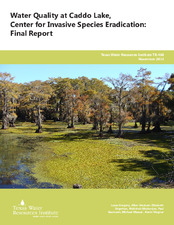| dc.description.abstract | Giant salvinia, a highly invasive aquatic fern native to South America, poses a serious threat to Texas’ waters and has done so since its discovery in the state in the 1990s. If left unmanaged, giant salvinia can cause a multitude of impacts including loss of recreational use, reductions in biodiversity, decreases in water quality, and monetary losses due to control costs and lost revenues. To counter this threat, the Center for Invasive Species Eradication (CISE) was created in 2010 with funding support from then U.S. Senator Kay Bailey Hutchison and the USDA Natural Resource Conservation Service (NRCS) to advance the knowledge about this species and treatment options and hopefully enable eradication of this noxious non-native plant species in Texas. Special focus of the Center’s efforts was placed on Caddo Lake. It is Texas’ only natural lake and has been plagued by giant salvinia since 2006. Levels of the invader present have risen and fallen with changes in weather and lake levels yet the threat it poses remains despite considerable treatment efforts. | en |


